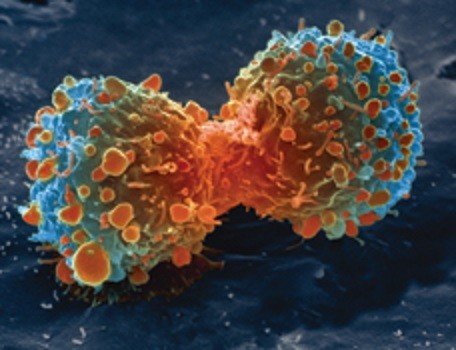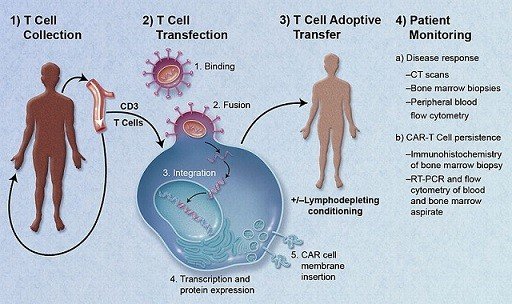Patients differ, Cancers are not the same...Factors Limiting CAR T-Cell Immunotherapy
Just imagine that malaria is actually caused by several strains of species of the Plasmodium genera, and that the "type" of malaria a patient has and how to treat it depends on the causative strain and the patient involved! And because of that, specialists will have to develop antimalarial drugs specifically for every patients tested positive to the disease! This would have been a setback of major concern to both the developers of the drug and the “community” of patients suffering from malaria, especially considering the Tropics where this disease is endemic.
This is the case of the advanced and “highly effective” immunotherapeutic approach to treating cancer, called the Chimeric Antigen Receptor (CAR) T-Cell therapy.
Cancer and Cancer Immunotherapy

Lung cancer cell dividing: wikimedia
As a result of uncontrolled growth of cells arising due to irregular expression of certain proteins, a group of diseases may arise such as all types of melanoma, lymphoma and many others. These diseases are referred to as cancer.
Simply defined, cancer immunotherapy means equipping the patient’s immune system to fight and eventually destroy cancerous cells. It involves the use of
- Monoclonal Antibodies, which are synthetic antibodies designed to target specific surface antigens of cancer cells and ultitmately cause their destruction. (this definition will "come in handy" at the later part of this article).
- Adoptive Cell Transfer therapy, which employs immune soldiers called T-Cells from the patient to fight and kill cancer cells also in the same patient.
- Immune Checkpoint Inhibitors, which are designed to prevent cancer cells from turning off the fighting potential of immune cells.
And many other immunotherapeutic approaches which I won't want to bore you with. But if you want to dig deep, see here.
Of major concern to this article is the “Chimeric Antigen Receptor” CAR T-Cell therapy, which is a type of adoptive cell transfer immunotherapy.
Chimeric Antigen Receptor (CAR) T-Cell Therapy
CAR T-Cell therapy collects Tumour-infiltrating T-cells from patient’s blood, modify these cells by adding synthetic receptors called ”chimeric antigen receptor, CAR”, which are specific for particular surface antigens on cancer cells of target, for example CD19 (an antigen found on B-Cells). The engineered or modified T-Cells (at this point, CAR T-Cells) are grown in vitro increasing them in millions. While this is done, the patient is made to undergo chemotherapy in an attempt to clear the way for CAR T-Cells by reducing the number of “rival fighters” (other immune cells). Then, they are infused back into the patient.

CAR T-Cell Therapy Stages: wikimedia
Although the "entire" cells in individual patient possess “the same” genetic material (DNA and genes) source except for nerve cells which were recently discovered/proposed to possess different characteristic genes, the way these genetic materials are expressed is what differentiate one cell from the other. So, cells are called specific names to differentiate them, for example, white blood cells and red blood cells. Since cancerous tumours arise from particular cells in the patient’s body, cancer cells, hence the cancer type differ from another.
Cells of different cancer types carry different antigens source. This exactly is the origin of one setback. As this means that for every cancer type, the kind of antigen the cancer cells carry must first be recognized, then the process of CAR T-Cell therapy follows suit.
Furthermore, because T-Cells must first be obtained from the patient suffering from a particular cancer type, modified to increase its recognizing ability for the specific antigen on the cells and then infused back into the patient, the same entire CAR T-Cell therapy materials cannot be used for any two patients suffering from the same cancer type, as T-Cells of one will not be welcomed by the immune cells of the other. This is another setback.
Hanging out with Monoclonal Antibodies
What I propose as the way to overcome this barrier is to engage the means by which cancer cells make themselves invisible to the immune system against them (the cancer cells). And this process is called "cancer immunoediting".
Using their "means of escape" against them
Research should focus on developing a “magic bullet” (probably an inactivated virus) that specifically invade “any” cancer cell causing them to undergo rapid mutations to produce genes that encode an abnormal protein that could serve as a man-made novel antigen on surface of cancer cells, and also develop monoclonal antibodies that targets this new antigen on the cancer cells. When the patient is later treated with these “novel antigen-specific” monoclonal antibodies, the cancer cells are easily recognized, attacked and destroyed. This way, ready-made monoclonal antibodies can be used on “any” patient suffering from “whatever” type or class of cancer.
What "way out" would you rather proffer to these situations?(thanks for the helping hand on T-cell transfusion, @suesa)
Comments are highly welcomed!
Thanks for reading!.
References
Hi @herbayomi!
Your post was upvoted by utopian.io in cooperation with steemstem - supporting knowledge, innovation and technological advancement on the Steem Blockchain.
Contribute to Open Source with utopian.io
Learn how to contribute on our website and join the new open source economy.
Want to chat? Join the Utopian Community on Discord https://discord.gg/h52nFrV
thanks, okay, I'll join straight away @utopian.io
i love this bro.... renowned microbiologist
Thanks bro... Haha, renowned???, okay!
wow.....brilliant write up @herbayomi.
thanks brother @emperorhassy